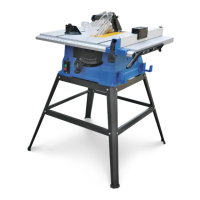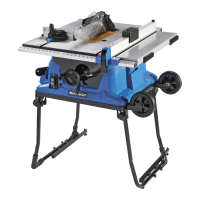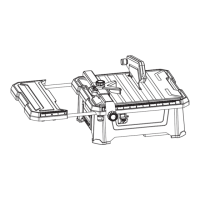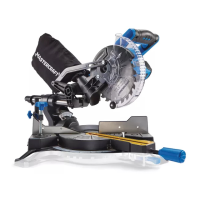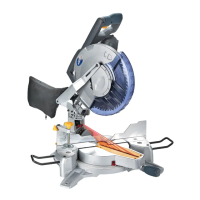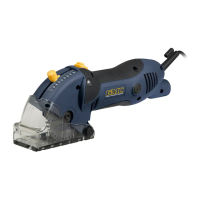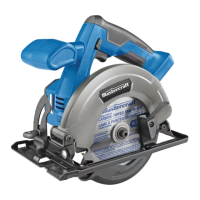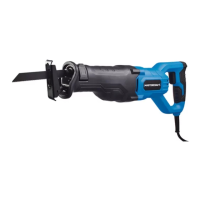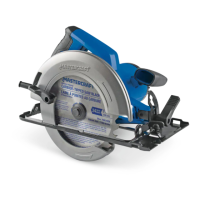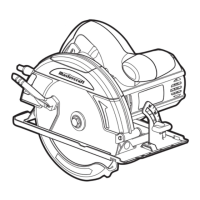10 11
model no. 055-6751-6 | contact us 1-800-689-9928
SAFETY GUIDELINES
SAFETY GUIDELINES
• Only use the correct blades. Use the correct blade size, style and cutting speed for the material and
the type of cut. Do not use blades with incorrect size holes. NEVER use blade washers or blade bolts
that are defective or incorrect. The maximum blade capacity for this saw is 10” (25.4 cm).
• Always keep blades clean, sharp and properly set. Sharp blades minimize stalling and kickback.
• Do not use dull or damaged blades. Bent blades can break easily or cause kickback.
• Never hold a workpiece by hand if it is too small to be clamped. Always keep your hands clear
of the “no hands” zone.
• Never apply lubricants to the blade when it is running.
• Never use solvents to clean plastic parts. Solvents could dissolve or otherwise damage the
material.
• Do not turn the motor switch on and off rapidly. This could cause the blade to loosen, which
could create a hazard. Should this ever occur, stand clear and allow the saw blade to come to a
complete stop. Disconnect the saw from the power source and tighten the blade bolt securely.
• Never leave the saw unattended while it is connected to a power supply.
• Keep the motor air slots clean and free of chips or dust. To avoid motor damage, the motor
should be blown out or vacuumed frequently. This keeps sawdust from interfering with the motor
ventilation.
• Never lift this tool by gripping the switch handle or by the mitre fence. This may cause
misalignment. Always lock the head assembly in the “Down” position and carry the saw by holding the
base or lift it using the carrying handle/support bracket.
ADDITIONAL RULES FOR SAFE OPERATION
• Know your power tool. Read the instruction manual carefully. Learn the applications and limitations,
as well as the specific potential hazards related to this tool. Following these rules will reduce the risk of
electric shock, fire or serious injury.
• Always wear safety glasses or eye shields when using this saw. Everyday eyeglasses have
only impact-resistant lenses; they are NOT safety glasses. All users and bystanders MUST wear eye
protection that conforms to ANSI Z87.1.
• Protect your lungs. Wear a face mask or a dust mask if the operation is dusty.
• Protect your hearing. Wear appropriate personal hearing protection during use. Under some
conditions and duration of use, noise from this product may contribute to hearing loss.
• All visitors and bystanders must wear the same safety equipment that the operator of the
saw wears.
• Inspect the tool cords periodically and, if damaged, have them repaired by a qualified person.
• Always check the tool for damaged parts. Before further use of the tool, a guard or other part that
is damaged should be carefully checked to determine whether it will operate properly and perform
its intended function. Check for misalignment or binding of moving parts, broken parts and any other
condition that may affect the tool’s operation. A guard or other part that is damaged should be properly
repaired or replaced by a qualified person.
• Save these instructions. Refer to them frequently and use them to instruct others who may
use this tool. If someone borrows this tool, make sure he or she has these instructions.
GLOSSARY OF WOODWORKING TERMS
• Spindle: The revolving shaft on which a blade or cutting tool is mounted.
• Allows the user to stop the blade from rotating while tightening or loosening the blade
screw during blade replacement or removal.
• Bevel Cut: A cutting operation made with the blade at any angle other than 90° to the mitre table.
• Chamfer Cut: A cut removing a wedge from a block of wood so the end (or part of the end) is angled
other than at 90°.
• Compound Mitre Cut: A cut made using both a mitre angle and a bevel angle at the same time.
• Crosscut: A cutting operation made across the grain of the workpiece.
• Freehand Cut: Performing a cut without using a fence, mitre gauge, fixture, work clamp, or other
proper device to keep the workpiece from twisting or moving during the cut. Do not perform any
operation freehand. Use a clamp or vice wherever possible.
• Kerf: The material removed by the blade in a through cut or the slot produced by the blade in a
non-through or partial cut.
• Kickback: A hazard that can occur when the blade binds or stalls, throwing the workpiece back
toward the operator.
• Mitre Cut: A cutting operation made with the blade at any angle other than 90° to the fence.
• No-Hands Zone: The area between the marked lines on the left and right side of the mitre table base.
This zone is identified by No-Hands Zone symbols inside the lines marked on the mitre table base.
• Non-through Cut: Any cutting operation where the blade does not extend completely through the
thickness of the workpiece.
• Revolutions Per Minute (RPM): The number of turns completed by a spinning object in one minute.
• Saw Blade Path: The area over, under, behind or in front of the blade, as it applies to the workpiece;
the area that will be or has been cut by the blade.
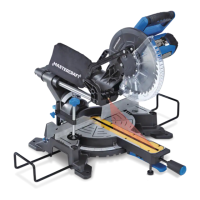
